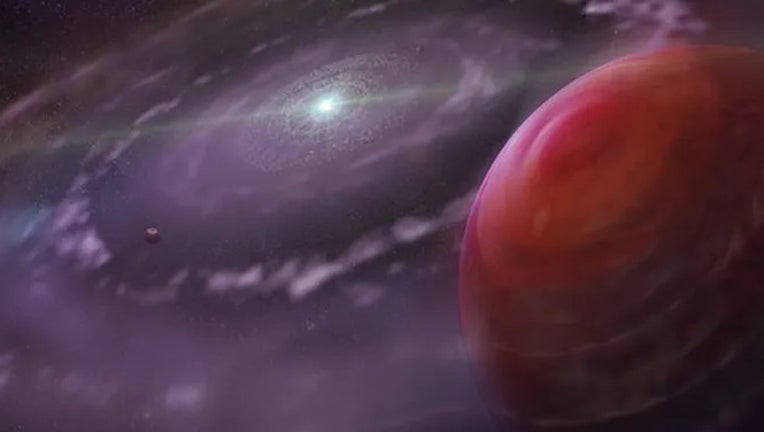Watch: Video shows distant worlds orbiting a star 133 light-years away

Artist's rendering of the planetary system HR 8799 at an early stage of its evolution, showing the planet HR879cc, a disk of gas and dust, and interior planets. (Dunlap Institute for Astronomy and Astrophysics/Mediafarm / NASA)
A new time-lapse video from Northwestern University shows four exoplanets, or planets located outside our solar system, orbiting their star for twelve years.
The exoplanets are located about 133 light-years from Earth in the Pegasus constellation, and they are 7-10 times more massive than Jupiter.
They orbit a star named HR8799, which is about 1.5 times more massive than our sun and approximately five times brighter.
On Tuesday, Northwestern University released a time-lapse video of this planetary system, providing a rare glimpse of HR8799 and its four orbiting planets.
Capturing the four orbiting worlds
At the center of the 4.5-second time-lapse is a yellow star, indicating the location of HR8799. Moving around it are four light blue dots, which are the four orbiting exoplanets.
"It’s usually difficult to see planets in orbit," said Jason Wang, Northwestern University astrophysicist who produced the video. "For example, it isn’t apparent that Jupiter or Mars orbit our sun because we live in the same system and don’t have a top-down view."
NASA SCIENTISTS DISCOVER EARTH-SIZED, ‘HABITABLE ZONE’ WORLD
Wang described the four exoplanets orbiting HR8799 as "scaled-up versions" of Jupiter, Saturn, Neptune and Uranus. According to Northwestern University, the planet closest to the star takes about 45 Earth years to complete one orbit, whereas one revolution for the farthest planet takes nearly 500 years.
An expert in exoplanet imaging, Wang created the video by using observations and imaging data of the extrasolar planetary system collected over the past 12 years.
Wang condensed the 12 years of data into a 4.5-second time-lapse, making the planetary orbits easier to see for human eyes.
ASTRONOMERS FIND 2 LIKELY ‘WATER WORLD’ EXOPLANETS
"Astronomical events either happen too quickly or too slowly to capture in a movie," Wang said. "But this video shows planets moving on a human timescale."
"I hope it enables people to enjoy something wondrous," he added.
How the timelapse was made
According to Northwestern University, Wang constructed the video by using various types of technology to make the images more clear.
For example, the Earth’s atmosphere caused blurring in the image, so Wang had to use technology called "adaptive optics" to correct the image.
NEWLY DISCOVERED ‘SUPER-EARTH’ EXOPLANET
He also had to suppress the glare from HR8799. The star was so bright in the images and made seeing the orbiting planets difficult, so a black circle was placed in the middle of the images – where the star is located – so the planets may be more visible.

By using the technique "direct imaging," the glare of a star is blocked to make any nearby planets more visible. (NASA)
Wang also had to smooth out the planets’ motion. Originally, the planets appeared to be jumping around rather than smoothly orbiting. So, Wang used a form of video processing to correct it.
According to Wang, using videos to explore space is the best part of his job.
"In astrophysics, most of the time, we are doing data analysis or testing hypotheses," he said. "But this is the fun part of science – it inspires awe."
HR8799 and its four orbiting planets were first imaged in November 2008, when they became the first extrasolar planetary system to be directly imaged.
This means that, unlike artist renderings illustrating – oftentimes beautifully – what celestial environments may look like, the images taken of the HR8799 system are direct images of the system itself.

